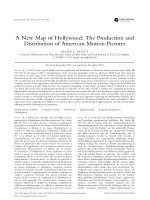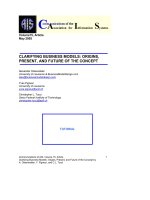samuelson - the great inflation and its aftermath; the past and future of american affluence (2008)
Bạn đang xem bản rút gọn của tài liệu. Xem và tải ngay bản đầy đủ của tài liệu tại đây (4.37 MB, 339 trang )
THE
GREAT
INFLATION
AND
ITS
AFTERMATH
THE PAST AND FUTURE OF
AMERICAN
AFFLUENCE
ROBERT
J.
SAMUELSON
NEWSWEEK AND WASHINGTON POST COLUMNIST
U.S.A.
$26.00
Canada $30.00
I
t's a giant gap in our history. The
Great
Inflation,
argues
award-winning columnist Robert
J.
Sam-
uelson in this provocative
book,
was the worst
domestic policy blunder of the postwar era and
played
a crucial role in transforming American poli-
tics,
economy, and everyday life—and yet its story is
hardly
remembered or appreciated. In these uncertain
economic times, it is more imperative than ever
that
we
understand what happened in the 1960s and 1970s,
lest
we be doomed to repeat our mistakes.
From
1960 to 1979, inflation rose from barely more
than 1 percent to nearly 14 percent. It was the great-
est peacetime inflationary spike in this nation's
his-
tory, and it had massive repercussions in every area of
our
lives.
The direct consequences included Ronald
Reagan's
election to the presidency in 1980, stagna-
tion
in
living standards, and a growing belief—both in
America
and abroad—that the great-power status of
the United States was ending. The
Great
Inflation
and
Its
Aftermath
traces the origins and rise of double-
digit
inflation and its
fall
in the brutal 1981-82 reces-
sion, engineered by the Federal Reserve under
then-
chairman Paul Volcker and with the staunch backing
of Reagan.
But
that
is only half the story The end of high
inflation triggered economic and social changes
that
are
still
with us. The stock market and housing
booms
were
both
direct outcomes; American business
became more productive—and also much
less
protec-
tive
of workers—and globalization was encouraged.
We
cannot understand today's world, Samuelson
contends, without understanding the
Great
Inflation
and its aftermath. Nor can we prepare for the future
unless
we heed its lessons. This incisive and enlight-
ening
book
will
stand as the authoritative account of
a
watershed event of our times.
ROBERT J.
SAMUELSON
is a
columnist
for
Newsweek
and The
Washington
Post.
He began his jour-
nalism
career as
a
reporter
for
the
Post
in 1969.
He is
the author of The
Good
Life
and Its
Discontents:
The
American
Dream
in
the Age of
Entitlement,
ip^j-ipçy
and
Untruth: Why
the
Conventional
Wisdom
Is
(Almost
Always)
Wrong,
a
collection
of his
columns.
He
lives
in
Bethesda,
Maryland,
with
his
wife,
Judy
Herr. They
have
three children.
Jacket
design:
Julie
Metz
Design
Join
our nonfiction e-newsletter by visiting www.rh-newsletters.com
Random
House
New
York,
N.Y.
©
2008
by Random
House,
Inc.
Praise
for
Robert
J.
Samuelson's
THE
GOOD
LIFE AND
ITS
DISCONTENTS
The American Dream
in the
Age
of
Entitlement, ip^f—ippf
A
New
York
Times
Business Book
Bestseller
"Original,
intellectually sound
and fun to
read."
—MANCUR
OLSON,
The
Wall
Street
Journal
"Shrewd
and
optimistic
combines first-rate analysis with
persuasive
historical, political and sociological insights."
—JAGDISH
BHAGWATI,
The New Republic
"A
smart, balanced
epitaph
for an
era—
with
a
few clues for what's ahead."
—ROBERT J. DOWLING,
BusinessWeek
"Lucid
[and] nonsectarian
Samuelson traces how
the reasonable demand for progress
has
given way
to
the excessive demand for perfection."
—ROBERT KUTTNER,
The New York
Times
ISBN
978-0-375-50548-5
ALSO
BY
ROBERT
J.
SAMUELSON
The Good Life and Its Discontents: The American
Dream in the Age of Entitlement, 1945-1995
Untruth: Why the Conventional Wisdom
Is (Almost Always) Wrong
THE
GREAT INFLATION
AND
ITS
AFTERMATH
RANDOM HOUSE
NEW YORK
ROBERT J. SAMUELSON
THE
GREAT INFLATION
AND ITS
AFTERMATH
THE PAST AND FUTURE OF
AMERICAN AFFLUENCE
Copyright © 2008 by Robert
J.
Samuelson
All rights reserved.
Published in the United States by Random House,
an imprint of The Random House Publishing Group,
a division of Random House, Inc., New York.
RANDOM HOUSE
and colophon are registered
trademarks of Random House, Inc.
LIBRARY
OF
CONGRESS CATALOGING-IN-PUBLICATION DATA
Samuelson, Robert J.
The great inflation and its aftermath
:
the past and
future of American affluence /
Robert
J.
Samuelson.
p.
cm.
Includes bibliographical references and index.
ISBN 978-0-375-50548-5
1.
Inflation (Finance)—United States. 2. United States—Economic policy.
3.
United States—Economic conditions. I. Tide.
HG540.S26 2008
332.4'10973—dc22 2008023468
Printed in the United States of America on acid-free paper
www.atrandom.com
24689753i
FIRST EDITION
Book design by Jessica Shatan Heslin/'Studio Shatan, Inc.
To Judy,
without whom this hook
would not have heen finished;
and without whom
it would not have hun worth finis
A Note to Readers xi
Acknowledgments xiii
Introduction xvii
1 :
The Lost History 3
2:
The "Full Employment" Obsession 47
3:
The Money Connection 75
4:
A Compact of Conviction 105
5:
Capitalism Restored 139
6: Precarious Prosperity 175
7:
The Future of Affluence 203
Glossary 249
Appendix 1: The American Economy Since 1950 259
Appendix 2: Post-World War II U.S. Business Cycles 267
Notes and Further Reading 271
Index 301
ix
Telling my story inevitably involves using some economic and fi-
nancial terms that may not be familiar to all readers. I have tried to
keep them to a minimum. On first usage, I have defined the terms.
Later references are usually freestanding. For those who want a re-
minder or further clarification, a glossary at the end of the book
provides detail. For the numerically inclined, two appendixes give
overviews of the American economy since World War II. The first
shows basic annual statistics—economic growth, unemployment,
inflation, interest rates, stock prices. The second describes business
expansions and recessions.
XI
A book is ultimately the responsibility of its author, but in the process
of becoming a book, it imposes burdens on many others. This book
is dedicated to my wife, Judy, on whom the burden was greatest.
Even in the best of times, I am not the easiest person to live with,
and as I struggled to make this book say what I wanted it to say, I be-
came even moodier than usual. The book evolved into an all-
purpose excuse not to do things I should have wanted to do and
that she wanted to do. "Oh no, we can't do that, because I've got to
work on the book" became a constant refrain. Judy responded with
routine encouragement, patient self-restraint and only infrequent
exasperation. Thanks,
Jude.
Next on the list of people who helped bring this project to con-
clusion is my longtime Newsweek colleague Richard Thomas, who
for many years was the magazine s chief economics correspondent.
He has forgotten more about the economy and its connections with
politics and the everyday lives of Americans than I will ever know.
xiii
Acknowledgments
Rich has that rare combination among journalists of superb report-
ing skills (which are common) and an unconventional mind (which
is rare) that allows him to see the larger significance of events even
as they are unfolding, and well before most others. Rich read count-
less drafts of the manuscript and made many valuable substantive
and editing suggestions. He also strove to be an amateur therapist,
repeatedly declaring that the manuscript was "brilliant" even as he
advised me to abandon entire sections of the "brilliant" draft or
amend it to increase its "brilliance." Rich deserves much credit for
the book's strong sections and warned me against some of the re-
maining weaknesses. Thanks to him for improving the manuscript
and toiling so hard to lift my spirits.
David Lindsey, a former top staff economist at the Federal Re-
serve, also read multiple drafts of the book and worked diligently to
ensure that I got the sequence of events correct and explained tech-
nical issues in terms that were clear and accurate. I may have failed,
but if
so,
it's not Dave's fault.
At a crucial point in the process of revising and rewriting, I asked
my old friend Jon Rauch—a writer for The Atlantic and National
Journal and a 2005 winner of the National Magazine Award, the
magazine equivalent of the Pulitzer Prize—to give me his impres-
sion. He read the whole thing, and by highlighting the book's
strengths and weaknesses—often echoing what Rich and my editor,
Jonathan Jao, had said—convinced me to do a fair amount of cut-
ting and rearranging. Jon's candor and clarity in identifying unnec-
essary parts of the manuscript improved it significantly.
A number of other people read the manuscript and made helpful
suggestions, not all of which I was smart enough to include: Joel
xiv
Acknowledgments
Havemann, the longtime editor for my column in The Washington
Post; my brother Richard and my cousin Richard (we Samuelsons
are not too original on names); Prakash Loungani, a friend and
economist at the International Monetary Fund; and John McCusker,
an economic historian at Trinity University in San Antonio. Thanks
also to Mark Zandi of Moody's Economy.com, who provided me
with much of the statistical information found in the two appen-
dixes and, aside from that, has consistently helped me understand the
economy. Malcolm Gillis, the ex-president of Rice University, in-
vited me to give a lecture at the university (where my daughter was
a student) that helped convince me to write the book. Pat Jackman
at the Bureau of Labor Statistics has, over the years, helped me bet-
ter understand the Consumer Price Index.
At the Federal Reserve, Dave Skidmore and Michelle Smith have
responded quicky and cheerfully to my many requests for informa-
tion, both in the course of my regular reporting and in the report-
ing for this book. Athanasios Orphanides, a former economist at the
Fed who has studied extensively the period from the late 1960s to
the early 1980s, gave me a very useful interview and provided some
helpful background material. (Orphanides has since left the Fed to
become the head of the Central Bank of Cyprus.) Allan Meltzer of
Carnegie Mellon University, author of a two-volume history of the
Fed, was kind enough to give me an advance copy of one chapter
from his forthcoming second volume. In an interview for this book
and over many years, he has also improved my understanding of the
economy and the making of economic policy.
Paul Volcker, former chairman of the Federal Reserve Board,
submitted to two interviews for the book and also reviewed parts of
XV
Acknowledgments
the manuscript for accuracy. I am indebted to him for his coopera-
tion. An interview with Alan Greenspan, Volcker's successor, was
also helpful in confirming the importance that he attached to
achieving a crude price stability.
At Random House, this book went through four editors—the
number had little to do with the book and mostly reflected changes
in the editors' personal lives (two of whom left Random House).
But in Jonathan
Jao,
I found an editor who skillfully maneuvered the
project to completion. His comments and suggestions were always
thoughtful and often confirmed what I had been hearing from oth-
ers.
Where I was disorganized, he was organized. When he said he
would do something, he did it—and did it when he said he would.
He was open-minded—he listened to all my suggestions and
pref-
erences—but also strong-willed when he thought I was wrong. And
he was always pleasant. My agent and neighbor, Rafe Sagalyn, re-
mained optimistic about the project even when there were ample
grounds for pessimism. As we walk our dogs, it will be easier now to
have relaxed conversations.
Finally, there are my children: Ruth, Michael and John. They
didn't have anything to do with the book. But they are everything
that life is about. They help me keep things in perspective, and they
are now old enough to have views of their own. After watching his
dad wrestle with this book, Michael made one of his affectionately
caustic suggestions: Don't do it again. It seems like good advice,
though it remains to be seen whether I will take it.
Inevitably, this book will contain errors of fact and interpretation.
For these, I claim exclusive responsibility.
xvi
INTRODUCTION
I decided to write this book because no one else had and, it ap-
peared, no one else would. It seemed obvious to me, as a journalist
covering the economy for the past half century, that the rise and fall
of double-digit inflation had exerted an enormous influence during
the entire period—and the effects were not confined to the econ-
omy. Because Americans place so much stock in their economy's
performance, inflation's roller coaster deeply influenced the nation's
psychology and politics. It also changed the way in which major
corporations managed their businesses and their workers. All these
relationships seemed fairly plain, and I waited for someone to make
the connections. Because I am a slow writer and my previous book
(The Good Life and Its Discontents: The American Dream in the Age of
Entitlement, 1945-1995) had exacted a huge toll in time and spirit,
I was not eager to begin a project that someone else was just finish-
ing. But no one else did, and so I set out to do it myself lest the
entire episode vanish from our collective consciousness.
xvii
Introduction
As with much of my journalism, the main aim here is to explain
what happened, why and with what consequences. The basic out-
lines of the story are straightforward. Ambitious economic doc-
trines,
embraced and promoted by some of the nation's leading
academic economists, promised to control the business cycle by
minimizing or eliminating recessions, but these ideas came to
grief.
The unintended side effects were not only higher inflation but also
more frequent and harsher recessions, stretching from the late 1960s
to the early 1980s. At the time, the resulting inflationary psychology
was so deeply embedded that almost everyone despaired at purging
it. Only the unexpectedly savage recession of 1981-82, when un-
employment peaked at nearly 11 percent, succeeded in doing so.
The aftermath of inflation's decline—and, to a significant extent, a
consequence of it—was a prolonged period of national prosperity,
marked by fewer and milder recessions. But simultaneously and
paradoxically, the aftermath also led to greater insecurity for individ-
ual firms and their workers. There is (and was) a connection. The in-
security and competitive pressures felt by individual firms and
workers were consequences of a less inflationary economy and, to
some extent, helped keep inflation in check.
In many ways, the book's publication—about two years later than
I originally expected—is more timely now than if I had written
faster and made my initial schedule. Until recently, the danger of
higher inflation seemed fairly remote; but as I write, in the early
summer of 2008, consumer prices are rising at about 5 percent a
year in the United States and, spurred by costlier oil and food, are
rising even faster in some other countries. It is now an open ques-
tion whether this modest rise of
U.S.
inflation is a prelude to some-
xviii
Introduction
thing much worse or simply an unfortunate aberration that will
soon give way to a return of price increases to an unthreatening
range of less than 2 percent a year. The book does have an unam-
biguous message about inflation: If we fail to contain it, we are
courting serious economic trouble, although we can't be entirely
certain what form that trouble will take. High inflation is an enor-
mously disruptive force.
Even if inflation subsides, there is another reason for the book's
timeliness. I argue that the roughly half century from 1960 until
now represents one long economic cycle dominated by inflation's
rise and fall—and that, in particular, the engines of economic ex-
pansion of the past quarter century are now largely spent. These in-
cluded strong increases in consumer spending based on rapidly
rising stock and home values, which in turn were heavily driven by
the falling interest rates that accompanied declining inflation. Ulti-
mately, the increases in stock and home prices inspired speculative
excesses that ended badly for many investors and home owners.
What started as sensible increases evolved into "bubbles." But even
when these excesses are purged from the economy, as has already
occurred for stocks, there will be no resumption of the outsized
gains that many Americans once falsely took for granted. Ameri-
cans'
economic confidence and the economy's expansion will need
other sources, and if they are not forthcoming, growth will slow. It
is important to recognize this change and understand why it is hap-
pening. The fact that this coincides with a presidential election is
also fortuitous. At the end of the book, I offer some suggestions as
to how we might improve our economic prospects.
As readers will discover, I view "the economy" as much more
xix
Introduction
than the amalgam of different markets for goods, services, labor, sav-
ings,
investment, work and leisure. To me, "the economy" is also a
social, political and psychological process. It is the convergence of
ideas,
institutions (private and public), values, beliefs, habits, tech-
nologies that intersect with one another to create our system of
pro-
duction and distribution. What this means is that changes in ideas,
institutions, values and beliefs can alter the way the economy works
just as much as—and sometimes more than—new technologies,
changes in prices or shifts in interest rates. The story I tell here traces
the evolution of the economy in this larger sense. It recounts how
one set of ideas and values gave way to another, because the first did
not live up to its promises, and how these changes affected politics,
popular attitudes and corporate management. The outward expres-
sion of these shifting ideas was rising and falling inflation; but the
price movements were consequences, not causes.
My book aims to serve a popular audience in the best sense of the
word. It's written for people who are reasonably curious and intelli-
gent. It does not presuppose specialized knowledge about the econ-
omy. I have tried to provide enough explanation and background to
make the story accessible to the specialist and the generalist, the
young and the old. Someone need not have lived through all these
events to grasp their significance. Although the book is intended
mainly for a general audience, I hope that its different perspective on
America's recent history will also prove illuminating for scholars—
economists, historians and political scientists. My aim is for readers
to come away with a better appreciation of how America got where
it is now and to understand why the story of inflation holds essen-
tial lessons for the future. These include not just the importance of
xx
Introduction
maintaining stable prices but also the desirability of judging proposed
public policies not by their advertised intentions (which are always
good) but by their likely long-run consequences (which are often
perverse).
Economic commentary tends to veer to one of two extremes.
Either we are going to paradise—some fabulous, unending boom,
created by a wondrous new technology, entrepreneurial genius or
flexible markets—or we're headed to hell, in the form of some
calamitous collapse or prolonged stagnation, brought on by foolish
speculation, uncompetitive companies, unskilled workers or dumb
government policies. Sensationalism, whether for good or ill, sells. I
have tried to avoid either extreme, believing that neither is usually
realistic. Over the years, I have been fairly optimistic about Amer-
ica's economic prospects. Our national culture—with its emphasis
on individual opportunity, hard work and striving—combined with
a robust business system, devoted to efficiency, growth and profits,
generally has put prosperity on a solid footing. Some evident past
problems (inflation, for one) were curable, though often at a cost.
Still, I admit that I have grown less optimistic in recent years, be-
cause we have been so lax in addressing obvious problems. We may
weaken our productive machine by inattention to clear and present
economic threats. In the concluding chapter, I mention some of
these: an aging society; an uncontrolled health-care sector that is
now approaching one-fifth of the entire economy; a world econ-
omy that might become dangerously unstable; and an uncritical re-
action to the possibility of global warming that may cause us to
undertake costly policies that, in the end, do little to affect global
warming but do weaken our economy's performance.
xxi









